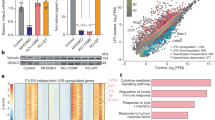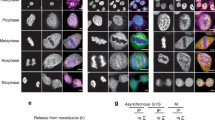Abstract
Histone deacetylase 3 (HDAC3) is an epigenome-modifying enzyme that is required for normal mouse development and tissue-specific functions. In vitro, HDAC3 protein itself has minimal enzyme activity but gains its histone-deacetylation function from stable association with the conserved deacetylase-activating domain (DAD) contained in nuclear receptor co-repressors NCOR1 and SMRT. Here we show that HDAC3 enzyme activity is undetectable in mice bearing point mutations in the DAD of both NCOR1 and SMRT (NS-DADm), despite having normal levels of HDAC3 protein. Local histone acetylation is increased, and genomic HDAC3 recruitment is reduced though not abrogated. Notably, NS-DADm mice are born and live to adulthood, whereas genetic deletion of HDAC3 is embryonic lethal. These findings demonstrate that nuclear receptor co-repressors are required for HDAC3 enzyme activity in vivo and suggest that a deacetylase-independent function of HDAC3 may be required for life.
This is a preview of subscription content, access via your institution
Access options
Subscribe to this journal
Receive 12 print issues and online access
$189.00 per year
only $15.75 per issue
Buy this article
- Purchase on Springer Link
- Instant access to full article PDF
Prices may be subject to local taxes which are calculated during checkout






Similar content being viewed by others
Accession codes
References
Choudhary, C. et al. Lysine acetylation targets protein complexes and co-regulates major cellular functions. Science 325, 834–840 (2009).
Grunstein, M. Histone acetylation in chromatin structure and transcription. Nature 389, 349–352 (1997).
Hebbes, T.R., Thorne, A.W. & Crane-Robinson, C. A direct link between core histone acetylation and transcriptionally active chromatin. EMBO J. 7, 1395–1402 (1988).
Lee, D.Y., Hayes, J.J., Pruss, D. & Wolffe, A.P. A positive role for histone acetylation in transcription factor access to nucleosomal DNA. Cell 72, 73–84 (1993).
Struhl, K. Histone acetylation and transcriptional regulatory mechanisms. Genes Dev. 12, 599–606 (1998).
Xu, L., Glass, C.K. & Rosenfeld, M.G. Coactivator and co-repressor complexes in nuclear receptor function. Curr. Opin. Genet. Dev. 9, 140–147 (1999).
Hassig, C.A. & Schreiber, S.L. Nuclear histone acetylases and deacetylases and transcriptional regulation: HATs off to HDACs. Curr. Opin. Chem. Biol. 1, 300–308 (1997).
de Ruijter, A.J., van Gennip, A.H., Caron, H.N., Kemp, S. & van Kuilenburg, A.B. Histone deacetylases (HDACs): characterization of the classical HDAC family. Biochem. J. 370, 737–749 (2003).
Haberland, M., Montgomery, R.L. & Olson, E.N. The many roles of histone deacetylases in development and physiology: implications for disease and therapy. Nat. Rev. Genet. 10, 32–42 (2009).
Knutson, S.K. et al. Liver-specific deletion of histone deacetylase 3 disrupts metabolic transcriptional networks. EMBO J. 27, 1017–1028 (2008).
Brehm, A. et al. Retinoblastoma protein recruits histone deacetylase to repress transcription. Nature 391, 597–601 (1998).
Ferreira, R., Magnaghi-Jaulin, L., Robin, P., Harel-Bellan, A. & Trouche, D. The three members of the pocket proteins family share the ability to repress E2F activity through recruitment of a histone deacetylase. Proc. Natl. Acad. Sci. USA 95, 10493–10498 (1998).
Luo, R.X., Postigo, A.A. & Dean, D.C. Rb interacts with histone deacetylase to repress transcription. Cell 92, 463–473 (1998).
Fraga, M.F. et al. Loss of acetylation at Lys16 and trimethylation at Lys20 of histone H4 is a common hallmark of human cancer. Nat. Genet. 37, 391–400 (2005).
Yeung, F. et al. Modulation of NF-κB–dependent transcription and cell survival by the SIRT1 deacetylase. EMBO J. 23, 2369–2380 (2004).
Feng, D. et al. A circadian rhythm orchestrated by histone deacetylase 3 controls hepatic lipid metabolism. Science 331, 1315–1319 (2011).
Sun, Z. et al. Hepatic Hdac3 promotes gluconeogenesis by repressing lipid synthesis and sequestration. Nat. Med. 18, 934–942 (2012).
Mullican, S.E. et al. Histone deacetylase 3 is an epigenomic brake in macrophage alternative activation. Genes Dev. 25, 2480–2488 (2011).
Fischle, W. et al. Enzymatic activity associated with class II HDACs is dependent on a multiprotein complex containing HDAC3 and SMRT/N-CoR. Mol. Cell 9, 45–57 (2002).
Zhang, J., Kalkum, M., Chait, B.T. & Roeder, R.G. The N-CoR-HDAC3 nuclear receptor co-repressor complex inhibits the JNK pathway through the integral subunit GPS2. Mol. Cell 9, 611–623 (2002).
Yoon, H.G. et al. Purification and functional characterization of the human N-CoR complex: the roles of HDAC3, TBL1 and TBLR1. EMBO J. 22, 1336–1346 (2003).
Li, J. et al. Both co-repressor proteins SMRT and N-CoR exist in large protein complexes containing HDAC3. EMBO J. 19, 4342–4350 (2000).
Guenther, M.G. et al. A core SMRT co-repressor complex containing HDAC3 and TBL1, a WD40-repeat protein linked to deafness. Genes Dev. 14, 1048–1057 (2000).
Guenther, M.G., Yu, J., Kao, G.D., Yen, T.J. & Lazar, M.A. Assembly of the SMRT-histone deacetylase 3 repression complex requires the TCP-1 ring complex. Genes Dev. 16, 3130–3135 (2002).
Sun, Z. et al. Diet-induced lethality due to deletion of the Hdac3 gene in heart and skeletal muscle. J. Biol. Chem. 286, 33301–33309 (2011).
Jepsen, K. et al. Combinatorial roles of the nuclear receptor co-repressor in transcription and development. Cell 102, 753–763 (2000).
Jepsen, K. et al. SMRT-mediated repression of an H3K27 demethylase in progression from neural stem cell to neuron. Nature 450, 415–419 (2007).
Bhaskara, S. et al. Deletion of histone deacetylase 3 reveals critical roles in S phase progression and DNA damage control. Mol. Cell 30, 61–72 (2008).
Privalsky, M.L. The role of co-repressors in transcriptional regulation by nuclear hormone receptors. Annu. Rev. Physiol. 66, 315–360 (2004).
Perissi, V. et al. Molecular determinants of nuclear receptor–co-repressor interaction. Genes Dev. 13, 3198–3208 (1999).
Aasland, R., Stewart, A.F. & Gibson, T. The SANT domain: a putative DNA-binding domain in the SWI-SNF and ADA complexes, the transcriptional co-repressor N-CoR and TFIIIB. Trends Biochem. Sci. 21, 87–88 (1996).
Codina, A. et al. Structural insights into the interaction and activation of histone deacetylase 3 by nuclear receptor co-repressors. Proc. Natl. Acad. Sci. USA 102, 6009–6014 (2005).
Hu, X. & Lazar, M.A. The CoRNR motif controls the recruitment of co-repressors by nuclear hormone receptors. Nature 402, 93–96 (1999).
Guenther, M.G., Barak, O. & Lazar, M.A. The SMRT and N-CoR co-repressors are activating cofactors for histone deacetylase 3. Mol. Cell. Biol. 21, 6091–6101 (2001).
Alenghat, T. et al. Nuclear receptor co-repressor and histone deacetylase 3 govern circadian metabolic physiology. Nature 456, 997–1000 (2008).
You, S.H., Liao, X., Weiss, R.E. & Lazar, M.A. The interaction between nuclear receptor co-repressor and histone deacetylase 3 regulates both positive and negative thyroid hormone action in vivo. Mol. Endocrinol. 24, 1359–1367 (2010).
Watson, P.J., Fairall, L., Santos, G.M. & Schwabe, J.W. Structure of HDAC3 bound to co-repressor and inositol tetraphosphate. Nature 481, 335–340 (2012).
Sinha, R.A. et al. Thyroid hormone stimulates hepatic lipid catabolism via activation of autophagy. J. Clin. Invest. 122, 2428–2438 (2012).
Jepsen, K. et al. SMRT-mediated repression of an H3K27 demethylase in progression from neural stem cell to neuron. Nature 450, 415–419 (2007).
Montgomery, R.L. et al. Maintenance of cardiac energy metabolism by histone deacetylase 3 in mice. J. Clin. Invest. 118, 3588–3597 (2008).
Henck, J.W., Mattsson, J.L., Rezabek, D.H., Carlson, C.L. & Rech, R.H. Developmental neurotoxicity of polybrominated biphenyls. Neurotoxicol. Teratol. 16, 391–399 (1994).
Mann, R.K. & Grunstein, M. Histone H3 N-terminal mutations allow hyperactivation of the yeast GAL1 gene in vivo. EMBO J. 11, 3297–3306 (1992).
Brownstein, M.J., Palkovits, M., Saavedra, J.M., Bassiri, R.M. & Utiger, R.D. Thyrotropin-releasing hormone in specific nuclei of rat brain. Science 185, 267–269 (1974).
Marks, P.A. & Dokmanovic, M. Histone deacetylase inhibitors: discovery and development as anticancer agents. Expert Opin. Investig. Drugs 14, 1497–1511 (2005).
Drummond, D.C. et al. Clinical development of histone deacetylase inhibitors as anticancer agents. Annu. Rev. Pharmacol. Toxicol. 45, 495–528 (2005).
Gronemeyer, H., Gustafsson, J.A. & Laudet, V. Principles for modulation of the nuclear receptor superfamily. Nat. Rev. Drug Discov. 3, 950–964 (2004).
Liu, X.F. & Bagchi, M.K. Recruitment of distinct chromatin-modifying complexes by tamoxifen-complexed estrogen receptor at natural target gene promoters in vivo. J. Biol. Chem. 279, 15050–15058 (2004).
Welsbie, D.S. et al. Histone deacetylases are required for androgen receptor function in hormone-sensitive and castrate-resistant prostate cancer. Cancer Res. 69, 958–966 (2009).
Hoberg, J.E., Yeung, F. & Mayo, M.W. SMRT derepression by the IkappaB kinase alpha: a prerequisite to NF-kappaB transcription and survival. Mol. Cell 16, 245–255 (2004).
Hong, S.H., Yang, Z. & Privalsky, M.L. Arsenic trioxide is a potent inhibitor of the interaction of SMRT co-repressor with Its transcription factor partners, including the PML-retinoic acid receptor α oncoprotein found in human acute promyelocytic leukemia. Mol. Cell. Biol. 21, 7172–7182 (2001).
Nofsinger, R.R. et al. SMRT repression of nuclear receptors controls the adipogenic set point and metabolic homeostasis. Proc. Natl. Acad. Sci. USA 105, 20021–20026 (2008).
Varlakhanova, N., Hahm, J.B. & Privalsky, M.L. Regulation of SMRT co-repressor dimerization and composition by MAP kinase phosphorylation. Mol. Cell. Endocrinol. 332, 180–188 (2011).
Juan, L.J. et al. Histone deacetylases specifically down-regulate p53-dependent gene activation. J. Biol. Chem. 275, 20436–20443 (2000).
Luo, J., Su, F., Chen, D., Shiloh, A. & Gu, W. Deacetylation of p53 modulates its effect on cell growth and apoptosis. Nature 408, 377–381 (2000).
Ashburner, B.P., Westerheide, S.D. & Baldwin, A.S. Jr. The p65 (RelA) subunit of NF-κB interacts with the histone deacetylase (HDAC) co-repressors HDAC1 and HDAC2 to negatively regulate gene expression. Mol. Cell. Biol. 21, 7065–7077 (2001).
Hubbert, C. et al. HDAC6 is a microtubule-associated deacetylase. Nature 417, 455–458 (2002).
Shimazu, T. et al. Regulation of SV40 large T-antigen stability by reversible acetylation. Oncogene 25, 7391–7400 (2006).
Grégoire, S. et al. Histone deacetylase 3 interacts with and deacetylates myocyte enhancer factor 2. Mol. Cell. Biol. 27, 1280–1295 (2007).
Heinz, S. et al. Simple combinations of lineage-determining transcription factors prime cis-regulatory elements required for macrophage and B cell identities. Mol. Cell 38, 576–589 (2010).
Acknowledgements
This work was supported by R37DK43806 (M.A.L.) and RC1DK86239 (M.A.L.) from the US National Institute of Diabetes, and Digestive and Kidney Diseases, and by a Mentor Based Fellowship from the American Diabetes Association (M.A.L. and S.-H.Y.). We thank T. Alenghat (Department of Pathobiology, University of Pennsylvania School of Veterinary Medicine, Philadelphia, Pennsylvania, USA) for early versions of the SMRT DAD targeting construct and K. Kaestner for help with gene targeting in C57BL/6 embryonic stem cells. We also acknowledge the Functional Genomics Core of the Penn Diabetes Research Center (DK19525), directed by K. Kaestner and J. Schug, for next generation sequencing.
Author information
Authors and Affiliations
Contributions
S.-H.Y. and M.A.L. conceived of the hypothesis and designed the experiments. S.-H.Y., Z.S. and M.B. performed the experiments. H.-W.L. and K.-J.W. analyzed bioinformatics data. S.-H.Y., Z.S. and M.A.L. analyzed and interpreted the data. S.-H.Y. and M.A.L. wrote the manuscript.
Corresponding author
Ethics declarations
Competing interests
The authors declare no competing financial interests.
Supplementary information
Supplementary Text and Figures
Supplementary Figures 1–5 and Supplementary Table 1 (PDF 423 kb)
Rights and permissions
About this article
Cite this article
You, SH., Lim, HW., Sun, Z. et al. Nuclear receptor co-repressors are required for the histone-deacetylase activity of HDAC3 in vivo. Nat Struct Mol Biol 20, 182–187 (2013). https://doi.org/10.1038/nsmb.2476
Received:
Accepted:
Published:
Issue Date:
DOI: https://doi.org/10.1038/nsmb.2476
This article is cited by
-
The role of HDAC3 and its inhibitors in regulation of oxidative stress and chronic diseases
Cell Death Discovery (2023)
-
Methylation across the central dogma in health and diseases: new therapeutic strategies
Signal Transduction and Targeted Therapy (2023)
-
Talaromyces marneffei suppresses macrophage inflammation by regulating host alternative splicing
Communications Biology (2023)
-
Xist spatially amplifies SHARP/SPEN recruitment to balance chromosome-wide silencing and specificity to the X chromosome
Nature Structural & Molecular Biology (2022)
-
HOXB13 suppresses de novo lipogenesis through HDAC3-mediated epigenetic reprogramming in prostate cancer
Nature Genetics (2022)



